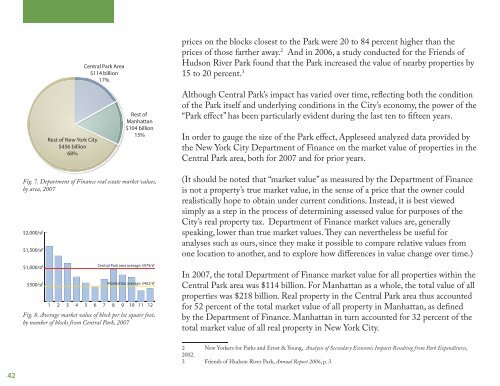Valuing Central Park's Contributions to New York City's ... - Appleseed
Valuing Central Park's Contributions to New York City's ... - Appleseed
Valuing Central Park's Contributions to New York City's ... - Appleseed
You also want an ePaper? Increase the reach of your titles
YUMPU automatically turns print PDFs into web optimized ePapers that Google loves.
2<br />
Rest of <strong>New</strong> <strong>York</strong> City<br />
$456 billion<br />
68%<br />
<strong>Central</strong> Park Area<br />
$114 billion<br />
17%<br />
Rest of<br />
Manhattan<br />
$104 billion<br />
15%<br />
Fig. 7. Department of Finance real estate market values,<br />
by area, 2007<br />
$2,000/sf<br />
$1,500/sf<br />
$1,000/sf<br />
$500/sf<br />
<strong>Central</strong> Park area average: $979/sf<br />
Manhattan average: $462/sf<br />
1 2 3 4 5 6 7 8 9 10 11 12<br />
Fig. 8. Average market value of block per lot square foot,<br />
by number of blocks from <strong>Central</strong> Park, 2007<br />
prices on the blocks closest <strong>to</strong> the Park were 20 <strong>to</strong> 84 percent higher than the<br />
prices of those farther away. 2 And in 2006, a study conducted for the Friends of<br />
Hudson River Park found that the Park increased the value of nearby properties by<br />
15 <strong>to</strong> 20 percent. 3<br />
Although <strong>Central</strong> Park’s impact has varied over time, reflecting both the condition<br />
of the Park itself and underlying conditions in the City’s economy, the power of the<br />
“Park effect” has been particularly evident during the last ten <strong>to</strong> fifteen years.<br />
In order <strong>to</strong> gauge the size of the Park effect, <strong>Appleseed</strong> analyzed data provided by<br />
the <strong>New</strong> <strong>York</strong> City Department of Finance on the market value of properties in the<br />
<strong>Central</strong> Park area, both for 2007 and for prior years.<br />
(It should be noted that “market value” as measured by the Department of Finance<br />
is not a property’s true market value, in the sense of a price that the owner could<br />
realistically hope <strong>to</strong> obtain under current conditions. Instead, it is best viewed<br />
simply as a step in the process of determining assessed value for purposes of the<br />
City’s real property tax. Department of Finance market values are, generally<br />
speaking, lower than true market values. They can nevertheless be useful for<br />
analyses such as ours, since they make it possible <strong>to</strong> compare relative values from<br />
one location <strong>to</strong> another, and <strong>to</strong> explore how differences in value change over time.)<br />
In 2007, the <strong>to</strong>tal Department of Finance market value for all properties within the<br />
<strong>Central</strong> Park area was $114 billion. For Manhattan as a whole, the <strong>to</strong>tal value of all<br />
properties was $218 billion. Real property in the <strong>Central</strong> Park area thus accounted<br />
for 52 percent of the <strong>to</strong>tal market value of all property in Manhattan, as defined<br />
by the Department of Finance. Manhattan in turn accounted for 32 percent of the<br />
<strong>to</strong>tal market value of all real property in <strong>New</strong> <strong>York</strong> City.<br />
2 <strong>New</strong> <strong>York</strong>ers for Parks and Ernst & Young, Analysis of Secondary Economic Impacts Resulting from Park Expenditures,<br />
2002.<br />
3 Friends of Hudson River Park, Annual Report 2006, p. 3.





